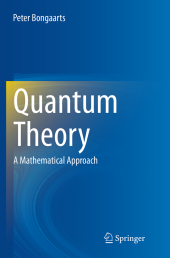 Neuerscheinungen 2016Stand: 2020-02-01 |
Schnellsuche
ISBN/Stichwort/Autor
|
Herderstraße 10
10625 Berlin
Tel.: 030 315 714 16
Fax 030 315 714 14
info@buchspektrum.de |

Peter Bongaarts
Quantum Theory
A Mathematical Approach
Softcover reprint of the original 1st ed. 2015. 2016. xxxii, 445 S. 8 SW-Abb. 235 mm
Verlag/Jahr: SPRINGER, BERLIN; SPRINGER INTERNATIONAL PUBLISHING 2016
ISBN: 3-319-37602-0 (3319376020)
Neue ISBN: 978-3-319-37602-8 (9783319376028)
Preis und Lieferzeit: Bitte klicken
This book was inspired by the general observation that the great theories of modern physics are based on simple and transparent underlying mathematical structures - a fact not usually emphasized in standard physics textbooks - which makes it easy for mathematicians to understand their basic features.
It is a textbook on quantum theory intended for advanced undergraduate or graduate students: mathematics students interested in modern physics, and physics students who are interested in the mathematical background of physics and are dissatisfied with the level of rigor in standard physics courses. More generally, it offers a valuable resource for all mathematicians interested in modern physics, and all physicists looking for a higher degree of mathematical precision with regard to the basic concepts in their field.
Introductory remarks.- Historical background.- Physics in The Twentieth Century and Beyond.- Methodological Remarks.- References.- Classical Mechanics.- Introduction.-- Historical Remarks.- Newtonian Classical Mechanics.- The Lagrangian Formulation of Classical Mechanics.- The Hamiltonian Formulation of Classical Mechanics.- An Intrinsic Formulation.- An Algebraic Reformulation.- References.- Quantum Theory: General Principles.- Historical Background.- The Beginning of Quantum Mechanics.- Quantum Theory. General Remarks.- The basic concepts of quantum theory.- A preview.- States and Observables.- Time Evolution.- Symmetries.- References.- Quantum Mechanics of a Single Particle I.- Introduction.- `Diagonalizing´ the Pj . The Fourier Transform.- A General Uncertainty Relation.- The Heisenberg Uncertainty Relation.- Minimal Uncertainty States.- The Heisenberg Inequality. Examples.- The 3-dimensional Case.5.- Quantum Mechanics of a Single Particle II.- Time Evolution of Wave Functions.- Pseudo-Classical Behavior of Expectation Values.- The Free Particle.- A Particle in a Box.- The Tunnel Effect.- The Harmonic Oscillator.- Introduction.- The Classical Harmonic Oscillator.- The Quantum Oscillator.- Lowering and Raising Operators.- Time Evolution.- Coherent States.- Time Evolution of Coherent States.- The 3-Dimensional Harmonic Oscillator.- The Hydrogen Atom.- Spin.- Many-Particle Systems.- Introduction.- Combining Quantum Systems - Systems of N Particles.- System of Identical Particles.- An Example: The Helium Atom.- Historical Remarks.- The Fock Space Formulation for Many-Particle Systems.- A Heuristic Formulation. `Second Quantization´.- References.- Review of Classical Statistical Physics.- Introduction.- Thermodynamics.- Classical Statistical Physics (Continued).- The Three main Ensembles.- The Microcanonical Ensemble.- The Canonical Ensemble.- The Grand Canonical Ensemble.- The Canonical Ensemble in the Approach of Gibbs.- From Statistical Mechanics to Thermodynamics.- Summary.- Kinetic Gas Theory.- General Statistical Physics.- References.- Quantum Statistical Physics.- Introduction.- What is an Ensemble in Quantum Statistical Physics?.- An Intermezzo - Is there a Quantum Phase Space?.- An Approach in Terms of Linear Functionals.- An Extended System of Axioms for Quantum Theory.- The Explicit Form of the Main Quantum Ensembles.- Planck´s Formula for Black Body Radiation.- Bose-Einstein Condensation.- References.- Physical Theories as Algebraic Systems.- Introduction.- `Spaces´. Commutative and Noncommutative.- An Explicit Description of Physical Systems I.- An Explicit Description of Physical Systems II.- Quantum Theory: Von Neumann Versus Birkhoff.- References.- Quantization. The Classical Limit.- Towards Relativistic Quantum Theory.- Introduction.- Einstein´s Special Theory of Relativity.- The Klein-Gordon Equation.- The Dirac Equation.- References.- An Introduction to Quantum Field Theory.- Introductory Remarks. Some History.- Quantum Field Theory as a Many Particle Theory.- Fock Space and its Operators.- The Scalar Quantum Field.- The Scalar Quantum Field.- The Field Operators.- The Scalar Field with Self-Interaction.- Towards a Rigorous Quantum Field Theory.- Concluding Remark.- References.


